Kitesurfing Straps: Performance and Safety Insights
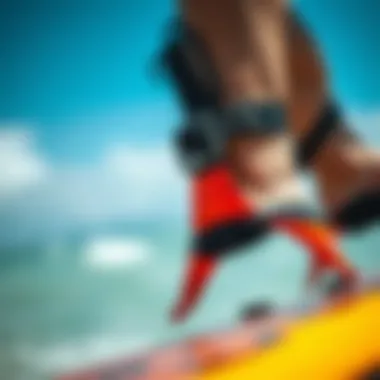
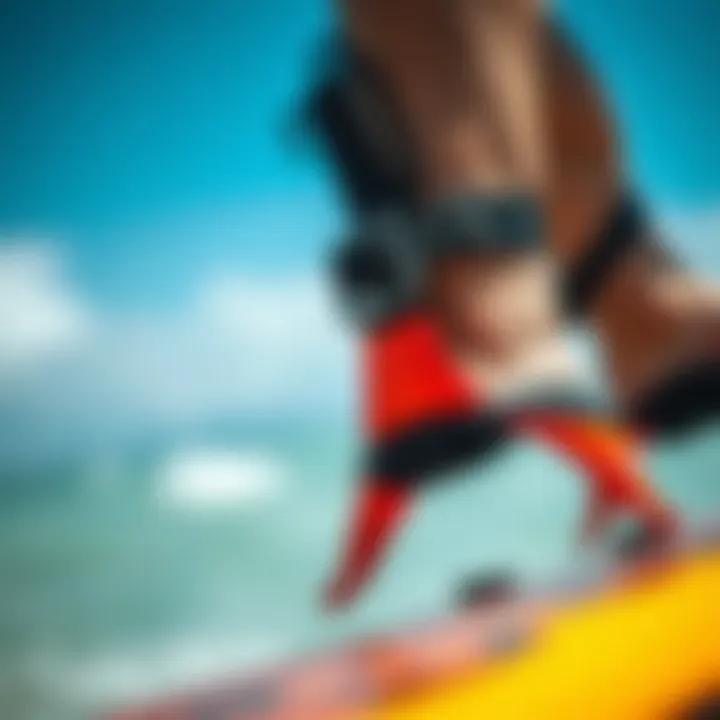
Intro
Kitesurfing is not just a sport; it’s a thrilling experience that captivates those who dare to ride the waves. An integral part of this experience involves the use of kitesurfing straps, which significantly influence both performance and safety. This article intends to unpack the multifaceted role of these straps—often an overlooked aspect in kitesurfing gear discussions. By highlighting different styles of straps, their materials, and the resulting impacts on your kitesurfing journey, readers will be well-equipped to make informed choices.
When engaging in kitesurfing, the right straps offer comfort and control, acting as a bridge between the rider and the board. Acknowledging the importance of these straps can elevate your performance while ensuring safety on the water. For novices exploring the kitesurfing world to seasoned enthusiasts looking for an edge, understanding the nuances of kitesurfing straps can enhance overall enjoyment.
Surfing Techniques
Beginner Tips for Getting Started
Starting off on the right foot—figuratively and literally—often hinges on the type of straps you choose. For beginner kitesurfers, opting for wider straps can provide extra stability. This added surface area helps in maintaining balance, especially when navigating choppy waters. It’s also wise to select adjustable straps. They allow for fine-tuning to fit different foot sizes and styles, enhancing comfort. Here are some essential tips:
- Experiment with Strap Tightness: Find a balance that keeps your foot secure while allowing enough movement. You want to avoid feeling like a statue on your board.
- Practice Foot Placement: Before hitting the waves, practice getting in and out of your straps on the beach. This will build familiarity and boost your confidence.
- Stay Flexible: Focus on bending your knees and maintaining a low center of gravity. A flexible stance can mitigate potential slips or falls.
Advanced Maneuvers and Tricks
Once you feel comfortable with the basics, you may want to explore advanced maneuvers. The type of straps you use can significantly affect your performance during these tricks. Many seasoned riders prefer foot straps that offer a tighter fit and more responsiveness.
Here are some tips for those ready to push their limits:
- Perfecting Jumps: Use straps that provide a secure hold as you soar; you don’t want your feet popping out mid-air. A snug fit will keep you connected to the board, aiding in control while landing.
- Exploring 360s and Spins: Consider a small pad or grip on the straps. This can help your feet stay locked during fast rotations.
- Adapt Your Style: Each trick requires a different approach, so experimenting with various strap setups can help find what works best for you.
By mastering these techniques and understanding the nuances of how straps impact performance, you can refine your approach and take your kitesurfing skills to new heights.
"The right equipment can be the difference between riding the wave and tumbling into the depths."
This guide to kitesurfing straps will continue to unfold, detailing board selection and maintenance, ensuring every aspect is covered for a comprehensive understanding of your kitesurfing journey. Stay tuned!
Understanding Kitesurfing Straps
Kitesurfing straps are far more than mere hardware; they represent a crucial connection between the rider and the board, affecting performance and safety on the water. Understanding these straps is essential for both novices and seasoned kitesurfers, as they influence not just the thrill of riding but also one’s ability to maneuver effectively in various conditions. The right straps can mean the difference between a smooth ride and an uncomfortable session full of mishaps.
Definition and Purpose
Kitesurfing straps refer to the components that secure the rider's feet to the board. In general, they're designed to provide stability, control, and confidence while riding. This seems simple enough, but the nuances of strap design—such as their material, shape, and adjustability—play pivotal roles in how they achieve these objectives.
Picture yourself out on the open water, the sun dancing on waves all around you, and the wind at your back. If your foot straps don’t fit right or you just can’t feel the board beneath you, that excitement can quickly turn into frustration. Comfort and security in your feet lead to better control over the board, allowing for enhanced tricks, jumps, and a more enjoyable ride overall. Essentially, the purpose of kitesurfing straps extends beyond mere attachment; they enhance the entire kitesurfing experience by providing a secure platform from which to navigate.
Importance in Kitesurfing
The significance of kitesurfing straps cannot be overstated. Firstly, they are instrumental in preventing foot slippage—one of the chief concerns for any kitesurfer. A well-fitted strap allows for efficient energy transfer from the body to the board, which is crucial for dynamic movements like carving or jumping.
Moreover, kitesurfing straps also play a critical role in safety. In moments of high wind or sudden changes in the environment, the ability to detach quickly from the board can prevent accidents. Not only should they hold your feet securely, but they should also feature a quick-release mechanism, enabling you to bail safely if conditions get rough.
"The right kitesurfing straps are not just accessories; they're lifelines, ensuring connection and safety while riding the tide."
Understanding the importance of kitesurfing straps also encompasses an awareness of how they can adapt to different skill levels. Beginners might prefer softer, more forgiving straps that provide a looser fit for comfort, while advanced riders may opt for stiffer, more locked-in designs to enhance performance and responsiveness. Ultimately, knowing which straps to use can vastly improve both learning and mastery of the sport.
With all those factors discussed, it’s clear that kitesurfing straps are a fundamental aspect of the experience. As we explore various types, materials, and designs, it becomes even more evident just how much effort goes into what might seem like simple pieces of equipment at first glance.
Types of Kitesurfing Straps
Understanding the various types of kitesurfing straps is crucial for those aiming to enhance their performance, safety, and overall enjoyment in kitesurfing. Each type of strap serves a distinctive purpose, catering not only to the rider's comfort but also to the functional dynamics of the sport. This section delves into the specifics of foot straps, board straps, and handle straps, providing insights into their designs and advantages.
Foot Straps
Foot straps are the connections between the rider’s feet and the kitesurfing board. Essential for control and stability, these straps come in various styles and sizes, adapting to a wide range of rider preferences. A well-fitted foot strap allows for greater responsiveness. On choppy waters or while landing jumps, the rider's footing needs to be secure yet flexible enough for quick movements.
- Design Variations: Some foot straps are lightweight and minimalist, designed for speed-loving riders, while others might be cushy and robust to give that padded support, ideal for those who might be tackling rougher waters.
- Adjustability: A strap with multiple adjustments can cater to different foot sizes and styles of riding. Being able to customize the tension and fit makes all the difference in both comfort and performance.
"Finding the right foot strap can turn a good session into an epic one; comfort is key, especially when you’re out there for hours."
Board Straps
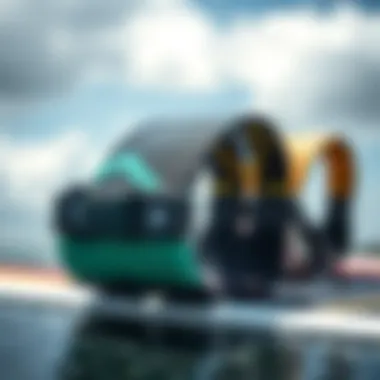
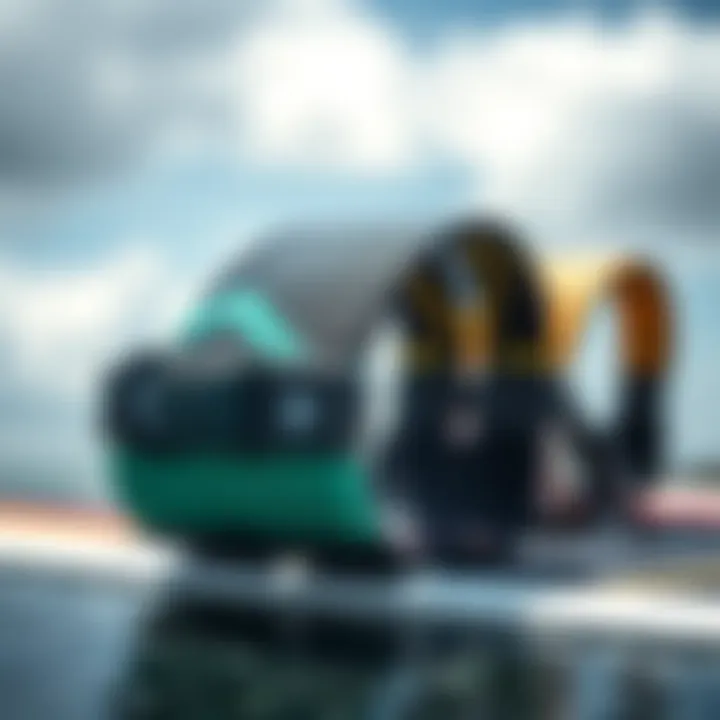
Board straps play a pivotal role in securing the foot straps and enhancing the overall buoyancy of the board. Although less talked about, their design and material composition heavily influence the performance during a ride. Rock-solid board straps are essential for those looking to maintain balance and control.
- Connection Features: Many boards now come equipped with innovative Velcro or quick-release features, allowing for swift adjustments. Riders can easily switch their stance or tighten their setup without a hassle.
- Material Considerations: Look for straps made from durable and lightweight materials that can withstand the saltwater and sun exposure. Boards equipped with high-quality straps are often more forgiving during landings, allowing for smoother transitions and preventing abrupt falls.
Handle Straps
Handle straps, while often overlooked, are pivotal for trick-oriented riding. These straps serve as a connection point for the rider's hands to the control system, often housing the safety leash. An effective handle strap adds another layer of safety while allowing riders to tackle challenging maneuvers.
- Grip and Comfort: A good handle strap often features a textured grip, ensuring that it remains firm even when wet. Riders will appreciate the ease of gripping during jumps or sharp turns.
- Weight Distribution: Well-designed handles balance weight effectively. This balance makes a world of difference when performing jumps or transitions, as the strap supports even the heaviest pull from the kite.
Materials Used in Kitesurfing Straps
The materials used in kitesurfing straps play a pivotal role in determining the overall durability, comfort, and performance of the straps. With kitesurfing being an exhilarating sport that combines the forces of wind and water, the right strap can make a world of difference. This section delves into the primary materials that comprise modern kitesurfing straps, examining their benefits and specific characteristics that make them suitable for this dynamic environment.
Neoprene
Neoprene is a popular choice in the production of kitesurfing straps due to its excellent cushioning properties and resilience. This synthetic rubber provides shock absorption, allowing kitesurfers to ride over waves and bumps without excessive impact on their feet or ankles. It doesn’t just stop there - neoprene also offers a degree of water resistance, which is beneficial during kitesurfing sessions.
Moreover, neoprene straps are often designed with specific characteristics:
- Flexible and Stretchy: This material adapts well to the shape of the foot, providing a snug fit that prevents slipping during intense maneuvers.
- Comfortable Against the Skin: Kitesurfers will appreciate neoprene’s soft texture, which reduces chafing and discomfort during prolonged use.
- Insulating Properties: For those who dare venture out in colder waters, neoprene also retains heat to some extent, providing warmth.
Overall, neoprene is a go-to material that encapsulates the needs of comfort and functionality for kitesurfers.
Plastic and Composite Materials
Apart from soft materials like neoprene, plastic and composite materials have carved their niche in the design of kitesurfing straps. These materials contribute strength, lightweight properties, and durability, all essential for the high-stakes demands of kitesurfing.
Key points to consider about plastic and composite materials include:
- Durability: They can withstand harsh conditions, UV exposure, and saltwater, ensuring that the straps last throughout the season and beyond.
- Customization: Many straps made from composite materials can be molded into various shapes and sizes, allowing manufacturers to cater to different styles and preferences.
- Weight Reduction: Lightweight plastic components reduce overall weight, which can enhance performance by allowing for quicker movements and easier reactions to the kite, especially in competitive settings.
Kitesurfers must pay attention to the specific types of plastics used, as not all are created equal. Advanced composites may include additional features like corrosion resistance or enhanced flexibility, making them ideal for serious enthusiasts.
Strength and Flexibility
When assessing kitesurfing straps, strength and flexibility are crucial factors. Straps need to endure significant tension and stresses during jumps and maneuvers. A strap that is too rigid might compromise performance and safety, while one that is too soft may lead to a lack of support.
Here’s what to keep in mind when evaluating strength and flexibility:
- Material Composition: The blend of materials significantly impacts the strap’s ability to stretch and recover. Finding a balance between robustness and elasticity ensures that the strap reacts well without losing its shape over time.
- Design Features: Some straps are engineered with reinforced areas that enhance durability without sacrificing flexibility at critical points. Look for models that incorporate these elements for enhanced performance.
- User Experience: Understanding your riding style influences the desired balance of strength and flexibility. Freestyle kitesurfers may prefer a stiffer strap for better control, while those who enjoy cruising may opt for a more flexible alternative.
In essence, strength and flexibility don’t just determine the longevity of a strap; they also dictate the overall kitesurfing experience. Finding the right combination is essential for maximizing performance and enjoying every ride.
Design Considerations for Kitesurfing Straps
When it comes to kitesurfing, every single detail can have a huge impact on performance and safety. One of those details is the design of kitesurfing straps. It might seem simple, but the shape, size, adjustability, and comfort of your straps can shape your overall experience on the water. That’s why understanding design considerations is not just a good idea, but an essential part of ensuring you ride with confidence and skill.
Shape and Size
The shape of kitesurfing straps dictates how well they fit your feet and board. Generally, straps come in various shapes—some are wider for better surface area contact and stability, while others may be narrower, designed for a snug fit. Each design has its own benefits. Wider straps can help distribute pressure evenly across your foot, which is especially useful for long rides. On the other hand, narrower straps might offer better control and are preferred by advanced riders looking to perform tricks.
Size is another critical factor. Foot size varies significantly among riders. Strap sizes should accommodate not just foot dimensions, but also any footwear you might choose to wear. Many straps feature adjustable sizes to fit a broader range of users, which is fantastic as it allows for some personalization. The ability to shift the strap's size helps many avoid blisters and discomfort. Ultimately, the right shape and size enhance the rider’s connection to the board, crucial for control and balance.
Adjustability
Let's talk about adjustability. Adjustability in design isn't just a luxury—it's a necessity. Not everyone’s foot is created equal, and what works for one may not cut it for another. Adjustable straps come with a few key benefits. Firstly, they allow a rider to tweak their fit on the fly, which is ideal if conditions change or if someone else wants to borrow your gear. Secondly, they can accommodate different styles of riding. For example, a freestyle rider might prefer a looser fit for certain maneuvers, while a wave rider may opt for it to be tighter for more stability in choppy waters.
Additionally, check the quality of the adjustment mechanism. Some straps use Velcro, while others might have buckles or other fasteners. A good mechanism ensures that the straps remain securely in place, even under the pull of a gusty wind. This feature is important: no one wants their feet slipping out of their straps mid-wave!
Comfort Features
Comfort is king when it comes to enjoying a good ride. Kitesurfing can be taxing on the body, especially the feet. Thus, having straps that include comfort features can significantly enhance your experience. Many modern straps are lined with soft materials like neoprene, which provides cushion and helps reduce friction. This padding not only adds comfort but also prevents those annoying and painful blisters that can ruin a day out.
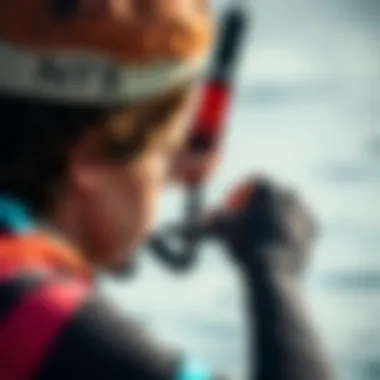
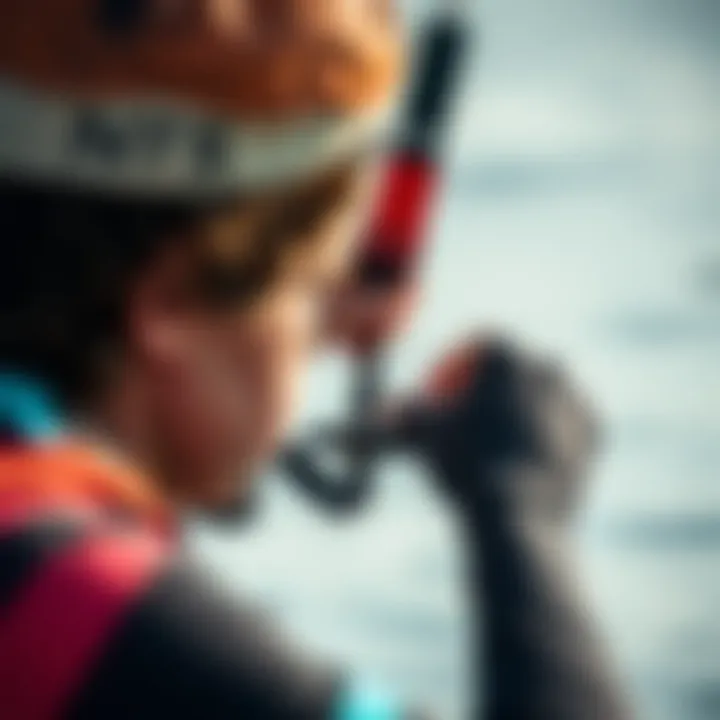
Moreover, some straps come with additional features, like shock absorption or cushioning systems. They help mitigate the impact as you land jumps or ride over rough waters. Comfort features can often determine whether a session is a joy or an ordeal.
In summary, choosing kitesurfing straps involves careful consideration of shape and size, adjustability, and comfort attributes. Understanding these components will aid you in selecting the perfect strap to match your riding style and preferences. Investing time in the right design will surely pay off when you’re out there carving up the waves.
"Comfort in kitesurfing starts with your straps; never overlook that detail!"
For more detailed insights on kitesurfing gear, you may want to check out resources like Wikipedia on Kitesurfing or look into specific forums at Reddit.
Remember that the more thought you put into your equipment, the more rewarding your kitesurfing experience will be.
How to Choose the Right Kitesurfing Straps
When it comes to kitesurfing, the right gear can make or break your experience. Among the crucial components, kitesurfing straps often go under the radar. Choosing the right kitesurfing straps is not just about style or brand; it’s about enhancing performance, ensuring safety, and enjoying your time on the water. With various factors to consider, such as your skill level, board compatibility, and budget, it’s vital to approach this decision with knowledge and thoughtfulness.
Skill Level Assessment
Understanding your own skill level is paramount in the selection process. For beginners, comfort and stability take precedence. This means opting for straps that ensure your feet are secure without excessive movement. A strap that allows some wiggle can actually help in getting a feel of balance, while also helping to minimize the risk of falls.
Intermediate and advanced riders can focus on performance-driven features. As skills improve, preferences change. You might seek narrow straps for better responsiveness or more rigid materials for support while executing jumps or tricks. Therefore, assessing where you stand in your kite surfing journey isn’t a mere formality; it’s the compass guiding your choices.
Board Compatibility
Matching your straps with the right board cannot be overstated. Not all straps fit all boards. Each board style, whether it's a twin tip or surfboard, has unique attachment points and designs that must align with the strap’s specifications. Failing to consider board compatibility may lead to an uncomfortable ride or worse, a potential safety hazard.
- Twin Tip Boards: Typically, they allow for adjustable straps that can adapt to different foot sizes. Look for straps with flexibility.
- Surfboards: These often require a more permanent strapping system. Straps should be streamlined, focusing on minimizing drag during turns.
- Freestyle Configurations: Riders often prefer a specific setting that impacts their ability to land jumps safely. Ensure your strap setup supports your riding style.
Budget Considerations
Financial constraints often play a role in gear selection. Kitesurfing straps range in price based on materials, design, and brand reliability. Setting a budget is wise, but it shouldn't sacrifice quality. Prices can fluctuate significantly based on the technology imbued in the straps.
- Entry-Level Straps: Often come with basic features focused more on comfort than performance. Suitable for new surfers who are just getting their feet wet, literally.
- Mid-Range Straps: Typically made of better materials, they balance durability with advanced features, which is suitable for intermediate riders.
- Premium Straps: For the advanced kitesurfer, these straps will usually bear a higher price tag, but they offer enhanced performance, comfort, and reliability that can significantly elevate your riding experience.
Ultimately, it's about understanding your own needs and matching them against what you’re willing to spend. Remember, a great bargain on a pair of straps is useless if it doesn’t serve your riding style or level.
"Choosing the right kitesurfing straps requires a good mix of understanding your skill level, ensuring board compatibility, and navigating your budget smartly. By taking time to assess each factor, you'll find the perfect match that enhances not just security but your entire kitesurfing adventure."
Equipped with these insights, you'll be better positioned to choose kitesurfing straps that resonate with your riding experience. It's not just about catching the wind; it’s about feeling secure while doing so.
Common Issues with Kitesurfing Straps
When it comes to kitesurfing, the importance of straps often takes a back seat to more ostentatious gear like the kite itself or the board. However, understanding the common issues related to kitesurfing straps is crucial for both performance and safety. Without proper attention to these potential problems, even the most skilled rider can find themselves in a tough spot.
Two prevalent concerns arise when discussing kitesurfing straps: wear and tear, and improper fit. Grasping these challenges helps enthusiasts maintain their gear, ensuring a smoother experience on the water.
Wear and Tear
Kitesurfing straps endure a fair amount of stress during use. They are subjected to the relentless forces of wind, water, and rider movement. Over time, this can lead to obvious wear and tear that can compromise both comfort and safety. Signs of this can include fading colors, frayed edges, or even dislodging from the board.
Ignoring these signs can lead to unfortunate outcomes. For instance, a split foot strap can throw a rider off balance or, worse, lead to a fall. Regularly inspecting your straps can save a lot of headache down the road. Look out for:
- Cracks or splits: This could indicate that the material is failing.
- Deteriorating padding: If the cushioning starts to flatten, it may not provide adequate support.
- Loose fittings: If the straps become loose over time, it can affect how well they hold you in place.
Taking precautions is essential. After each session, give your straps a quick once-over. Regular checks and early replacements can elevate your kitesurfing experience, ensuring that you stay securely connected to your board regardless of the conditions.
Improper Fit
Another key issue to consider is improper fit. Straps that are either too tight or too loose can not only diminish performance but also pose risks of injury. A snug fit is vital to maintain control while maneuvering across the water, but comfort should also not be sacrificed. When kitesurfing straps are poorly adjusted, they can lead to cramping or fatigue, distracting you from the thrill of riding the waves.
Here are a few things to consider to avoid improper fit:
- Test different settings: Straps are often adjustable, so take the time to experiment with how tight or loose they should be based on your comfort level.
- Make sure your feet are correctly positioned: Feet should sit naturally in the straps, with toes just barely pushing against the material.
- Pay attention to your foot type: Some riders have wide feet, while others may have narrow ones. Make sure you select straps that can comfortably accommodate your unique foot shape.
Ultimately, ensuring a proper fit not only heightens your comfort but also enhances your performance on the water. Paying attention to common issues like wear and tear as well as fit is essential for an optimal kitesurfing experience.
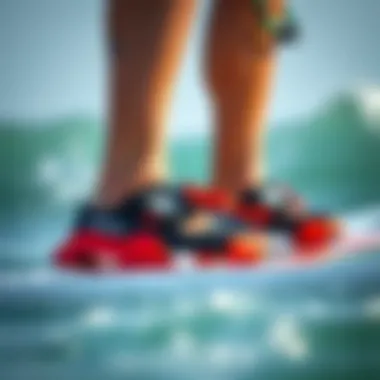
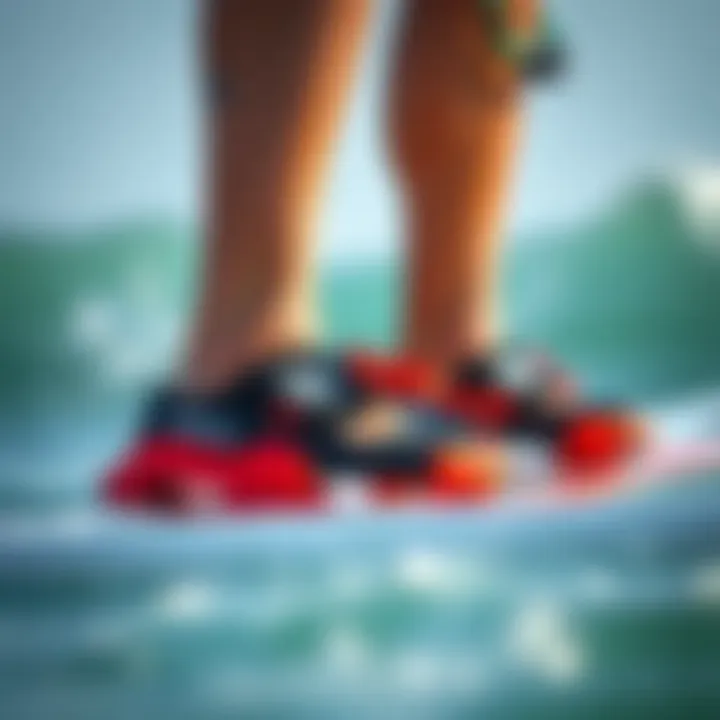
"A skilled rider is not defined solely by the kite, but also by how well they manage all the elements that keep them connected to their board."
Finale
It's easy to overlook the minute details when you're caught up in the thrill of kitesurfing. However, addressing the common issues of wear and tear and improper fit can make a world of difference in achieving a safe and enjoyable ride. Regular maintenance and attentiveness to these elements can ultimately extend the lifespan of your gear and elevate your overall experience in the sport.
Maintenance of Kitesurfing Straps
Proper maintenance of kitesurfing straps is not just a wise move; it’s a necessity for both performance and safety on the water. Straps that are well-maintained can make a noticeable difference in how the rider feels during their session. By regularly caring for your straps, you can improve their longevity and ensure they keep performing well. This section discusses why maintenance matters and highlights specific elements to consider.
Regular Inspections
Conducting regular inspections of kitesurfing straps is crucial. It helps identify wear and tear before it leads to potential accidents. Just like with any gear, your straps face daily challenges, from saltwater to sand, not to mention the pressures of use under various wind conditions. An inspection could be a simple glance at the straps for visible damage or a more thorough check, including:
- Webbing Frays: Over time, the webbing can fray or weaken, especially at points where it connects to the board or around the foot area.
- Buckles and Fasteners: Make sure buckles are not rusted or damaged, which could compromise functionality.
- Surface Integrity: Look for signs of cracking or wear, particularly on plastic or composite components. An ounce of prevention here can save a big headache later.
It's like checking an engine; a small oversight can lead to a bigger problem down the road. Having a routine inspection plan—much like your gym schedule—will keep your gear in top shape and you riding confidently.
Cleaning and Care
Cleaning your kitesurfing straps is another essential part of maintenance. After each session, rinse off any saltwater and sand using fresh water. Salt can corrode materials and sand can create unnecessary friction, which can shorten the life of your straps. Here are a couple of guidelines for keeping your straps clean:
- Rinse: After a day out, always rinse the straps in fresh water. This simple step helps remove salt and sand that may damage the material over time.
- Soak and Scrub: If you notice stubborn dirt, soak the straps in a mild detergent solution. Use a soft brush to scrub any tough spots gently.
- Dry Properly: Avoid drying in direct sunlight, as UV rays can degrade materials. Instead, lay out the straps in a shaded area to dry naturally.
Taking care of your straps doesn’t have to be a chore, but it does take a bit of diligence. When you keep your straps clean, you’re not only enhancing their lifespan but also ensuring they perform at their best, which is what every kitesurfer aims for.
"Regular care makes gear last longer and keeps you focused on the ride, not the gear."
By committing to regular inspections and proper cleaning, you won’t just prolong the life of your kitesurfing straps; you’ll also improve your overall experience on the water. As with everything else in kitesurfing, a little effort goes a long way in enhancing both performance and safety.
Future Trends in Kitesurfing Strap Technology
The world of kitesurfing straps is not stagnant; rather, it is constantly evolving to meet the demands of both recreational and competitive riders. The importance of staying abreast of future trends in kitesurfing strap technology can't be overstated. As the sport advances, so too does the technology that enhances the rider's experience. With every innovation, there's an opportunity to improve performance, safety, and comfort on the water, which cannot be overlooked.
Innovative Materials
In the realm of kitesurfing straps, innovative materials are increasingly the name of the game. Traditional straps made from basic neoprene and plastic are rapidly being supplemented or replaced by advanced materials that offer superior performance. For example, companies are experimenting with carbon fiber composites, which can dramatically reduce the overall weight of the strap without compromising strength. This shift not only enhances maneuverability but also provides an improved level of control during high-speed runs or aerial maneuvers.
Another material seeing heightened usage is durable synthetic textiles like Dyneema or Kevlar. These materials are renowned for their strength and longevity, significantly extending the life of kitesurfing straps while maintaining lightweight properties. Riders can be assured that these straps won’t wear out as easily, even under rigorous conditions.
- Benefits of Innovative Materials:
- Improved durability and performance
- Lightweight and easy to handle
- Potential for better safety through advanced strength
As manufacturers focus on sustainability, eco-friendly materials are on the rise. Next-gen straps developed from recycled plastics don't just aim to enhance performance; they also contribute to saving the environment, aligning the sport with broader ecological goals.
Enhanced Ergonomics
Another key trend in kitesurfing strap technology is enhancing ergonomics. The correct ergonomic design can lead to a world of difference in riding experience, as it allows riders to maintain comfort and control even during long sessions. Straps that conform to the shape of a rider's foot improve connection with the board, allowing for greater responsiveness. This design element can reduce fatigue and greatly optimize performance.
With advancements in 3D printing technology, the customization of fit is becoming a practical reality. Riders can have straps tailored to the contours of their feet, accommodating their unique anatomy. This level of customization helps alleviate discomfort and can even mitigate the risk of injuries stemming from improper gear fit.
- Key Aspects of Enhanced Ergonomics:
- Custom fit for individualized comfort
- Improved foot-to-board connection
- Reduction of fatigue during extended sessions
Gone are the days when kitesurfing straps were simply a functional attachment to the board. Now, with considerations for style, fit, and user comfort, aesthetics and performance are woven together seamlessly. Expect to see an increase in straps that not only perform well but also look good doing it, providing riders with options to express their personal style without compromising on the essentials.
Culmination and Final Thoughts
Reflecting on the journey through the realm of kitesurfing straps, we notice how integral these pieces of equipment are to one's experience on the water. Regardless of whether you’re a budding enthusiast or a seasoned expert, making informed decisions about straps can significantly affect performance and overall enjoyment. The right strap not only enhances your grip but also ensures safety while allowing for a more fluid interaction with the board and kite.
In the dynamic world of kitesurfing, strap technology continues to blossom, suggesting that what works today may not be the gold standard tomorrow. Innovations in materials and design are pushing the boundaries, promising improved comfort and adaptability for all riders. It’s wise to stay attuned to these advancements, as they often reflect broader trends in sports gear technology, giving an edge to those who embrace change.
A couple of vital points resonate as we wrap up this exploration:
- Prioritize Fit and Comfort: An ill-fitting strap can lead to discomfort, affecting not just your performance but your enjoyment as well. Take the time to choose straps that align with your foot size, riding style, and preferences.
- Regular Maintenance is Key: Keeping your straps in top shape requires minimal effort but pays off massively. Regular inspections and care can prolong their lifespan and ensure they perform well under pressure.
Engaging with the kitesurfing community, sharing experiences, and seeking feedback are invaluable. Forums and discussion platforms like reddit.com can provide insights on the latest gear and personal experiences from other kitesurfing enthusiasts.
Ultimately, when one considers all these aspects—design choices, material quality, user compatibility—the right kitesurfing strap becomes more than just a piece of equipment; it transforms into a partner for every adventure on the water. The conversations surrounding kitesurfing gear don't need to be mere whispers. They deserve the boldness to inspire choices that elevate every wave ridden and every gust conquered.



